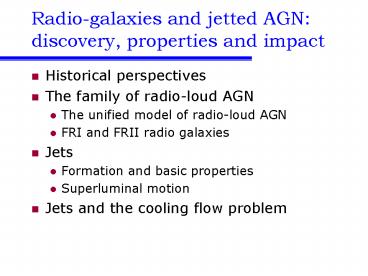Radiogalaxies and jetted AGN: discovery, properties and impact - PowerPoint PPT Presentation
1 / 27
Title:
Radiogalaxies and jetted AGN: discovery, properties and impact
Description:
Used 'Lunar occultation' to localize 3C273. I.e., measure the precise time when the radio signal from the quasar is blocked by the Moon... – PowerPoint PPT presentation
Number of Views:25
Avg rating:3.0/5.0
Title: Radiogalaxies and jetted AGN: discovery, properties and impact
1
Radio-galaxies and jetted AGNdiscovery,
properties and impact
- Historical perspectives
- The family of radio-loud AGN
- The unified model of radio-loud AGN
- FRI and FRII radio galaxies
- Jets
- Formation and basic properties
- Superluminal motion
- Jets and the cooling flow problem
2
IV.10 The discovery of AGN
- Early 1960s
- Radio astronomers started to survey the sky
- Found many mysterious radio sources
- Quasi-stellar radio sources (quasars for short)
- Very difficult to identify radio images were too
fuzzy to allow quasars to be localized on sky - Cyril Hazard
- Used Lunar occultation to localize 3C273
- I.e., measure the precise time when the radio
signal from the quasar is blocked by the Moon - then use knowledge of the Moons position to
determine position of quasar. - Hazard could localize 3C273 to about 1 arcsec.
3
Parkes
4
- M.Schmidt
- Took Hazards position and observed it with
optical telescope in particular, he took a
spectrum - Clearly observed emission lines of hydrogen, but
spectrum showed huge redshift, z0.158 - Hubbles law ? huge distance (747 Mpc using WMAP
cosmology) - Thus, object must be 1000x more powerful than
regular galaxy
5
IV.11 Radio-loud AGN
- 3C273 is an example of a radio-loud AGN a
significant fraction of its luminosity emerges in
the radio band - Nature of radio-loud AGN
- Detailed studies with radio interferometers
showed that radio emission was often coming from
an extended region - Often showed a double structure
- Martin Rees suggested that the radio emission is
powered by jets emerging from the immediate
region around a black hole
6
(No Transcript)
7
Cygnus-A
Cygnus-A
FRII high power systems that brighten at the
edges (edge-brightened). Often look like
directed explosions.
8
Of course, jets arent only seen in the radio
band!
9
The zoo of radio-loud AGN
- Radio-galaxies
- Strong extended radio emission but rather weak
nucleus display either narrow optical emission
lines (NLRG) or broad optical emission lines
(BLRG) - Radio-loud quasars
- Strong extended radio emission and a
strong/variable nucleus showing broad optical
emission lines - Blazars
- Strong and variable emission across the whole
spectrum no emission lines highly polarized
10
Unified model of AGN difference between
radio-loud quasars and radio-galaxies is
orientation
11
Radio-galaxies are sub-divided into
Faranoff-Riley (FR) classes
FR-I low power systems that are bright in the
center and then fade off at the edges, i.e.,
edge darkened. Look like smoke-stacks
12
Cygnus-A
Cygnus-A
FRII high power systems that brighten at the
edges (edge-brightened). Often look like
directed explosions.
13
Whats wrong with this galaxy?
14
IV.12 Properties of jets
- We want to know
- How fast are jets traveling?
- How much energy do they carry?
- What are they made of?
- Normal matter (protonselectrons)?
- Pair plasma (electronspositrons)?
- Poynting flux?
- How are they accelerated and collimated?
- Why do some AGN have jets and others do not?
15
IV.12 Properties of jets
- We want to know
- How fast are jets traveling?
- How much energy do they carry?
- What are they made of?
- Normal matter (protonselectrons)?
- Pair plasma (electronspositrons)?
- Poynting flux?
- How are they accelerated and collimated?
- Why do some AGN have jets and others do not?
?
16
How fast are jets traveling?
- Best constraints come from direct observations of
blobs moving in AGN jets - In some jets, see superluminal motion apparent
motion exceeding the speed of light - Strong evidence that the jet material is moving
at relativistic velocities see discussion on
board
17
How much energy is carried by jets?
- Generally hard to determine
- Can estimate power if we see interaction of jet
with surroundings - E.g., jets can blow bubbles in the hot (X-ray
emitting) gas - Can estimate power needed to blow bubbles
Central galaxy of the Centaurus cluster
18
How are the jets powered?
- Dont know how jets are powered! But we know
that some jet sources are efficient - Use X-ray observations to estimate density
temperature of hot gas close to BH - Then compute Bondi accretion rate find efficient
conversion of accreted mass-energy into jet power - Probably has something to do with winding of
B-fields by the accretion disk
Allen et al. (2006)
19
(No Transcript)
20
IV.13 The heating of the ISM/ICM by AGN jets
- Back to the effect that AGN jets have on massive
galaxies and cluster cooling flows - Computer simulations can be used to model the
interaction of jets with the surrounding ISC/ICM
21
3-d single-burst case / Density (ZEUS-MP v1.5)
Pure cooling
Single-burst jet
22
Instantaneous fueling scenario
23
Instantaneous fueling scenario
24
Delayed fueling scenario
25
Delayed fueling scenario with ICM rotation
26
(No Transcript)
27
Unsharp mask of the 900ks Chandra observation of
the Perseus cluster (Fabian et al. 2005)































